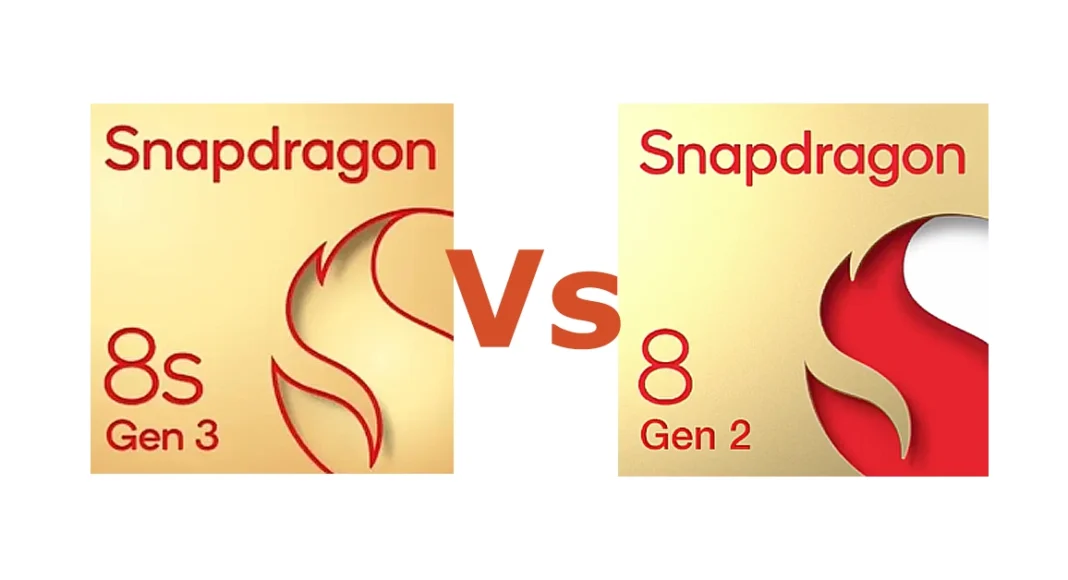Qualcomm’s new Snapdragon 8s Gen 3 SoC will be seen in a lot of midrange smartphones this year. With specs comparable to the premium 8 Gen 3 chipset, the 8s Gen 3 carries the ‘flagship killer’ reputation. We compared the two chipsets earlier, and the 8 Gen 3 unsurprisingly emerged as the clear winner. A comparison with last year’s flagship chipset seemed the logical step, so we’ve done just that in this article. Take a look at how the Snapdragon 8s Gen 3 fares against the Snapdragon 8 Gen 2.
Read Also: Krafton announces Battlegrounds Mobile India Series (BGIS) 2024
| Parameter | Snapdragon 8s Gen 3 | Snapdragon 8 Gen 2 |
| Process Node | TSMC 4nm | TSMC 4nm |
| CPU | Octa-core Kyro CPU - Advertisement -
1 Prime Cortex-X4 Core (3.0 GHz) 4 Performance Cores (2.8 GHz) 3 Efficiency Cores (2.0 GHz) |
Octa-core Kyro CPU
1 Prime Cortex-X3 Core (3.2GHz) - Advertisement -
4 Performance Cores (2.8 GHz) 3 Efficiency Cores (2.0GHz) |
| GPU | Adreno 735
Hardware Accelerated Ray Tracing |
Adreno 740
Hardware Accelerated Ray Tracing |
| NPU | Hexagon NPU | Hexagon NPU |
| Camera Support | 4K HDR videos @ 60fps
Up to 200MP photo capture Slow-mo 1080p videos @ 240fps |
8K HDR videos @ 30fps
4K HDR videos @ 120fps Up to 200MP photo capture Slow-mo 720p videos @ 960fps |
| Connectivity | WiFi 7, Bluetooth 5.4, LE | WiFi 7, Bluetooth 5.3, LE |
| Modem | Snapdragon X70 5G Modem
Maximum Download Speed: 5Gbps Maximum Upload Speed: 3.5Gbps |
Snapdragon X70 5G Modem
Maximum Download Speed: 10Gbps Maximum Upload Speed: 3.5Gbps |
| Storage/RAM Support | UFS 4.0 LPDDR5X memory up to 4,200MHz | UFS 4.0 LPDDR5X memory up to 4,200MHz |
In This Article
Snapdragon 8s Gen 3 vs 8 Gen 2: CPU
The Snapdragon 8s Gen 3 and 8 Gen 2 are based on TSMC’s 4nm process node. Both chipsets feature 8 Kyro CPU cores but with a different layout. The prime Cortex-X4 core on the 8s Gen 3 is clocked at 3.0GHz. Meanwhile, the S8G2 SoC uses the 3.2GHz Cortex-X3 as its prime core. There are four performance cores (Cortex-A720) on the 8s Gen 3 running at 2.8GHz and three efficiency cores (Cortex-A520) clocked at 2.0GHz. The Snapdragon 8 Gen 2 has two Cortex-A715 performance cores clocked at 2.8GHz, another two Cortex-A710 performance cores running at 2.8GHz, and three efficiency cores (Cortex-A510) running at 2.0GHz. Both CPUs are pretty evenly matched, but the 8s Gen 3 edges it with a slim margin. Its performance cores produce a better output than 2023’s flagship chipset.
Snapdragon 8s Gen 3 vs 8 Gen 2: CPU
The Snapdragon 8 Gen 2 has the better GPU out of the two chipsets. The clock speed of 8s Gen 3’s Adreno 735 has not been made public by Qualcomm as of yet. S8G2’s Adreno 740 GPU clocks at 680MHz. The former scores 550k in benchmark tests while the latter reaches up to 600k. The Adreno 735 is an underclocked version of the Adreno 750 and sits below the Adreno 740 in the hierarchy.
Snapdragon 8s Gen 3 vs 8 Gen 2: AI
AI tech keeps evolving rapidly every year, leading to better-performing chipsets. 2024’s 8s Gen 3 SoC outperforms the 8 Gen 2 even though both chipsets share the same Hexongonal NPU. The S8sG3 can run on-device AI models with up to 10 billion parameters. This makes it equipped to handle tasks like AI image generation and operating AI virtual assistants. The chipset also supports more than 30 Large Language Models (LLMs) and Large Vision Models (LVMs).
Snapdragon 8s Gen 3 vs 8 Gen 2: Camera support
Both chipsets allow photo capture up to 200MP but the S8G2 is the clear winner when it comes to video recording support. 2023’s flagship chipset can facilitate 8K video recordings at 30 fps and 4K recordings at 120 fps. It can also take 720p slow-motion videos at 960 fps. Meanwhile, the 8s Gen 3 lacks support for 8K videos. It can record 4K videos at 60 fps. Its slow-motion recording chops are limited to 240 fps, albeit at a better resolution (1080p).
Snapdragon 8s Gen 3 vs 8 Gen 2: Storage and connectivity
Talking about the storage specs, both chipsets offer UFS 4.0 storage and LPDDR5X memory. However, the S8sG3 has more favourable transfer speeds due to the presence of USB 3.1 Gen 2. The S8G2 supports USB 3.1 Gen 1. Both chipsets use the same modem (Snapdragon X70) but have vastly different download speeds. The 8s Gen 3 lags behind with speeds of up to 5Gbps while the 8 Gen 2 can reach speeds of up to 10Gbps. The upload speed on both chipsets is 3.5Gbps. The two chipsets rock the latest WiFi 7, but the S8sG3 edges ahead with Bluetooth 5.4. The S8G2 SoC supports Bluetooth 5.3.
Read Also: How to transfer your Amazon Music Playlists to Spotify and Vice Versa?
Verdict
While there was a clear winner in the comparison between Snapdragon 8sG3 and 8G3, the two chipsets here are more evenly matched. The 8sG3 very narrowly comes ahead in the CPU department with its powerful performance cores. However, the GPU on Snapdragon 8 Gen 2 is inarguably better. For us, the key difference lies in the AI department, with the 8s Gen 3 proving to be a better chipset and handling on-device AI models with up to 10 billion parameters. This makes it a better chipset for 2024 smartphones, which will be looking to catch up to the AI trailblazers in Samsung Galaxy S24 and Google Pixel 8.




